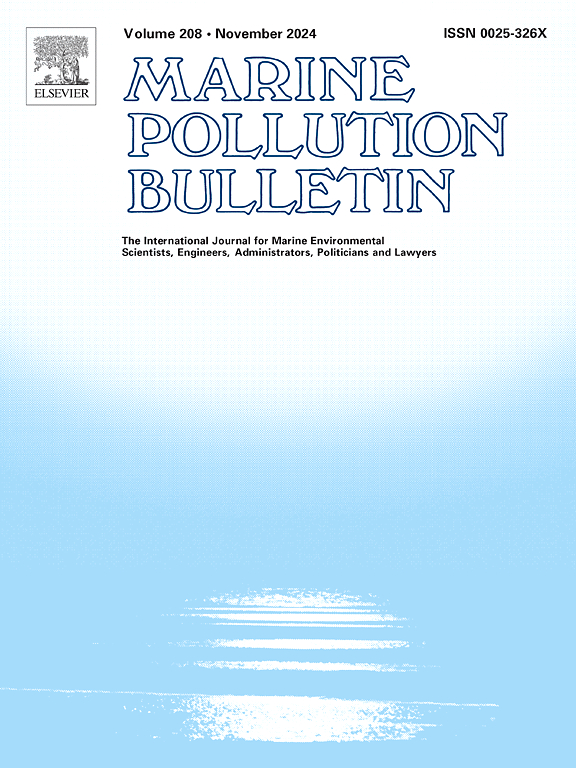2050年英国船舶NOx, SOx, PM10和PM2.5的排放:决定因素是什么,到2050年实现零污染是否可行,这些污染物的减少速度是否相同?
IF 4.9
3区 环境科学与生态学
Q1 ENVIRONMENTAL SCIENCES
引用次数: 0
摘要
本研究调查了2050年英国船舶排放的氮氧化物、硫氧化物、PM10等污染物。PM2.5,以评估零污染的决定因素,可行性,以及减排是否会同步进行。2016年英国航运业的排放量被用作基准情景,预计2025年英国航运业的能源需求与2016年相同。分析了三种燃料混合情景:一种以电子燃料为主(情景1),一种以生物燃料为主(情景2),以及一种中心情景(情景3)。通过将污染物的排放因子应用于这些情景,预计2050年英国船舶总排放量的千吨范围为氮氧化物(307-942),硫氧化物(4-7)和PM10和PM2.5的1-8。与2016年情景相比,情景1的氮氧化物、硫氧化物、PM10和PM2.5的总减排率分别为- 27%、95%、99%和99%;情景2为25%、96%、87%和87%;场景3为59、97、52、52。这些发现表明,到2050年在该行业实现这些污染物的零污染是不可行的,它们的减排速度不会以同样的速度发展,而且有利于减少碳排放的某些燃料组合将不可避免地增加氮氧化物排放。进一步分析表明,燃料混合类型和能源需求这两个关键因素将显著影响这些排放。因此,提出了包含更多氢燃料的新燃料方案,并产生了有希望的结果。因此,增加氢燃料的比例,加上减少个人污染物的技术,将有助于解决这些排放问题。本文章由计算机程序翻译,如有差异,请以英文原文为准。

2050 UK shipping emissions of NOx, SOx, PM10, and PM2.5: What are the determining factors, is the zero pollution by 2050 feasible, and will the reduction rate for these pollutants be at the same pace?
This study investigates 2050 UK shipping emissions for NOx, SOx, PM10 & PM2.5, to assess the determining factors, feasibility of zero pollution, and whether the emission reduction will progress at the same pace. The 2016 UK shipping emissions was used as the baseline scenario, with 2025 UK shipping energy demand expectedly the same as that of 2016. Three fuel-mix-scenarios were analysed: one dominated by e-fuels (Scenario 1), one dominated by biofuels (Scenario 2), and a central case (Scenario 3). By applying the pollutants' emission factors to these scenarios, the range of the projected 2050 UK total shipping emissions in kilotons were NOx (307-942), SOx (4-7), and 1-8 for both PM10 and PM2.5. Compared to the 2016 scenario, the total emission reduction rates for NOx, SOx, PM10 and PM2.5, respectively were ‐27, 95, 99, and 99 % for Scenario 1; 25, 96, 87, and 87 % for Scenario 2; and 59, 97, 52, and 52 for Scenario 3. These findings revealed that achieving zero pollution in the sector for these pollutants by 2050 is not feasible, their emission reduction rates will not progress at the same pace, and that certain fuel mix which favour carbon emission reduction, will invariably increase NOx emission. Further analysis revealed that two key factors—fuel mix type and energy demand—will significantly influence these emissions. Consequently, new fuel scenarios incorporating more of hydrogen fuel are proposed, yielding promising results. Therefore, increased proportion of hydrogen fuel, coupled with technologies for individual pollutant reduction will help address these emissions.
求助全文
通过发布文献求助,成功后即可免费获取论文全文。
去求助
来源期刊

Marine pollution bulletin
环境科学-海洋与淡水生物学
CiteScore
10.20
自引率
15.50%
发文量
1077
审稿时长
68 days
期刊介绍:
Marine Pollution Bulletin is concerned with the rational use of maritime and marine resources in estuaries, the seas and oceans, as well as with documenting marine pollution and introducing new forms of measurement and analysis. A wide range of topics are discussed as news, comment, reviews and research reports, not only on effluent disposal and pollution control, but also on the management, economic aspects and protection of the marine environment in general.
 求助内容:
求助内容: 应助结果提醒方式:
应助结果提醒方式:


